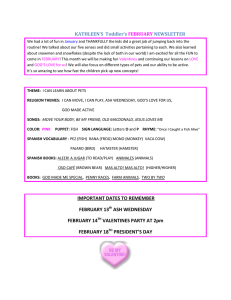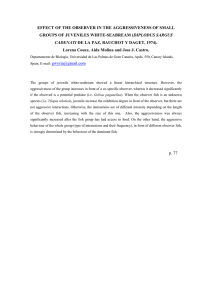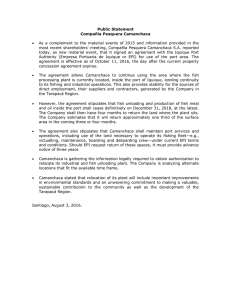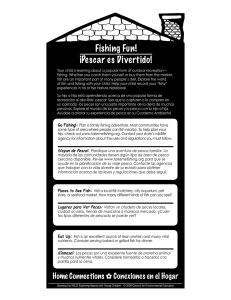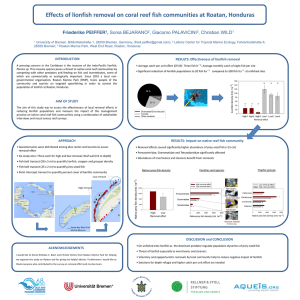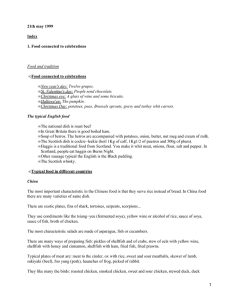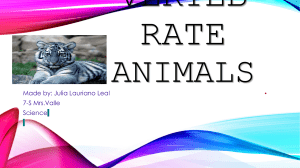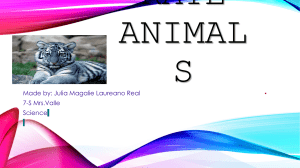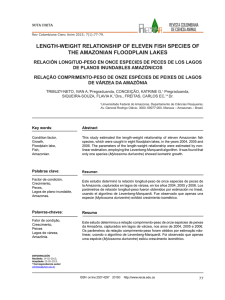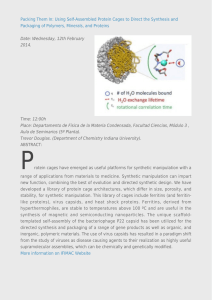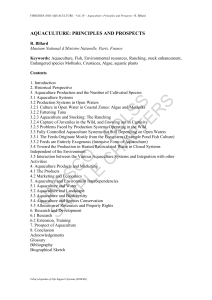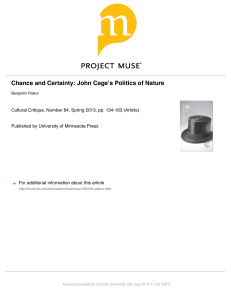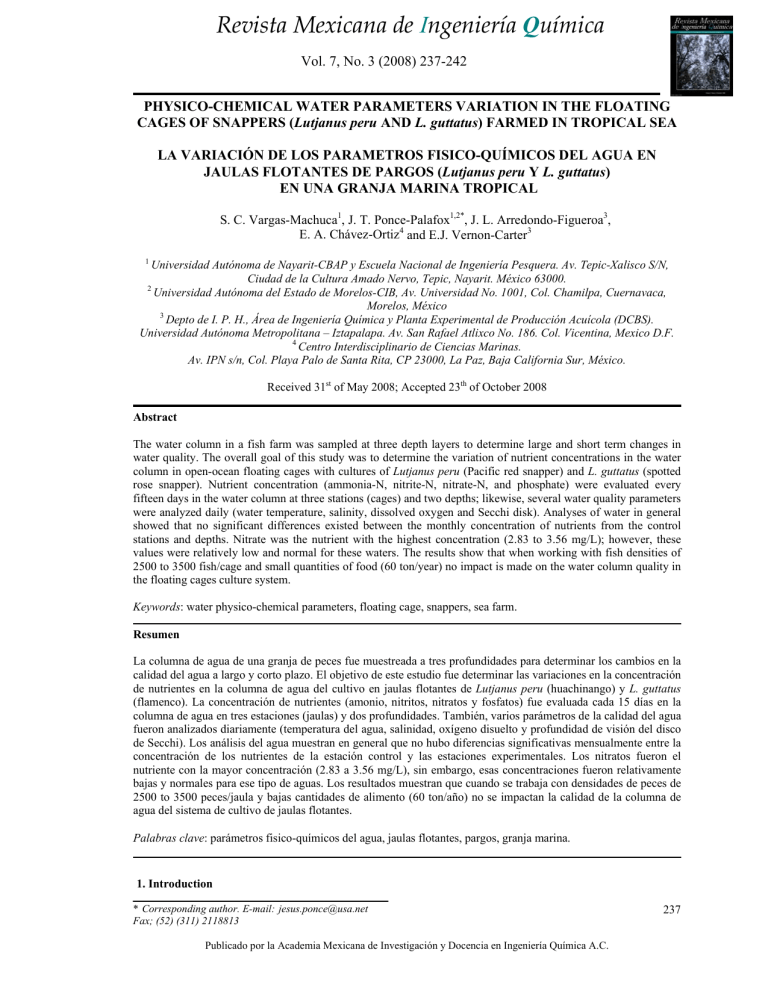
Revista Mexicana de Ingeniería Química Vol. 7, No. 3 (2008) 237-242 PHYSICO-CHEMICAL WATER PARAMETERS VARIATION IN THE FLOATING CAGES OF SNAPPERS (Lutjanus peru AND L. guttatus) FARMED IN TROPICAL SEA LA VARIACIÓN DE LOS PARAMETROS FISICO-QUÍMICOS DEL AGUA EN JAULAS FLOTANTES DE PARGOS (Lutjanus peru Y L. guttatus) EN UNA GRANJA MARINA TROPICAL S. C. Vargas-Machuca1, J. T. Ponce-Palafox1,2*, J. L. Arredondo-Figueroa3, E. A. Chávez-Ortiz4 and E.J. Vernon-Carter3 1 Universidad Autónoma de Nayarit-CBAP y Escuela Nacional de Ingeniería Pesquera. Av. Tepic-Xalisco S/N, Ciudad de la Cultura Amado Nervo, Tepic, Nayarit. México 63000. 2 Universidad Autónoma del Estado de Morelos-CIB, Av. Universidad No. 1001, Col. Chamilpa, Cuernavaca, Morelos, México 3 Depto de I. P. H., Área de Ingeniería Química y Planta Experimental de Producción Acuícola (DCBS). Universidad Autónoma Metropolitana – Iztapalapa. Av. San Rafael Atlixco No. 186. Col. Vicentina, Mexico D.F. 4 Centro Interdisciplinario de Ciencias Marinas. Av. IPN s/n, Col. Playa Palo de Santa Rita, CP 23000, La Paz, Baja California Sur, México. Received 31st of May 2008; Accepted 23th of October 2008 Abstract The water column in a fish farm was sampled at three depth layers to determine large and short term changes in water quality. The overall goal of this study was to determine the variation of nutrient concentrations in the water column in open-ocean floating cages with cultures of Lutjanus peru (Pacific red snapper) and L. guttatus (spotted rose snapper). Nutrient concentration (ammonia-N, nitrite-N, nitrate-N, and phosphate) were evaluated every fifteen days in the water column at three stations (cages) and two depths; likewise, several water quality parameters were analyzed daily (water temperature, salinity, dissolved oxygen and Secchi disk). Analyses of water in general showed that no significant differences existed between the monthly concentration of nutrients from the control stations and depths. Nitrate was the nutrient with the highest concentration (2.83 to 3.56 mg/L); however, these values were relatively low and normal for these waters. The results show that when working with fish densities of 2500 to 3500 fish/cage and small quantities of food (60 ton/year) no impact is made on the water column quality in the floating cages culture system. Keywords: water physico-chemical parameters, floating cage, snappers, sea farm. Resumen La columna de agua de una granja de peces fue muestreada a tres profundidades para determinar los cambios en la calidad del agua a largo y corto plazo. El objetivo de este estudio fue determinar las variaciones en la concentración de nutrientes en la columna de agua del cultivo en jaulas flotantes de Lutjanus peru (huachinango) y L. guttatus (flamenco). La concentración de nutrientes (amonio, nitritos, nitratos y fosfatos) fue evaluada cada 15 días en la columna de agua en tres estaciones (jaulas) y dos profundidades. También, varios parámetros de la calidad del agua fueron analizados diariamente (temperatura del agua, salinidad, oxígeno disuelto y profundidad de visión del disco de Secchi). Los análisis del agua muestran en general que no hubo diferencias significativas mensualmente entre la concentración de los nutrientes de la estación control y las estaciones experimentales. Los nitratos fueron el nutriente con la mayor concentración (2.83 a 3.56 mg/L), sin embargo, esas concentraciones fueron relativamente bajas y normales para ese tipo de aguas. Los resultados muestran que cuando se trabaja con densidades de peces de 2500 to 3500 peces/jaula y bajas cantidades de alimento (60 ton/año) no se impactan la calidad de la columna de agua del sistema de cultivo de jaulas flotantes. Palabras clave: parámetros fisico-químicos del agua, jaulas flotantes, pargos, granja marina. 1. Introduction * Corresponding author. E-mail: jesus.ponce@usa.net Fax; (52) (311) 2118813 Publicado por la Academia Mexicana de Investigación y Docencia en Ingeniería Química A.C. 237 S. C. Vargas-Machuca et al./ Revista Mexicana de Ingeniería Química Vol. 7, No. 3 (2008) 237-242 The lixiviation of organic wastes is one of the main causes affecting the water quality in aquaculture farming. Food beneath fish farms is available to wild fishes in the vicinity as large food pellets lost through the cages, dead cultured fishes and a ‘soup’ of broken pellets and feaces from caged fishes (Dempster et al., 2004, 2005). The load of nutrients originating from a cage culture system can be divided into a dissolved fraction and a particulate fraction; these nutrients can precipitate and accumulate in the sediments. Enrichment of the water column with dissolved nutrients and bottom sediments with organic matter as a result of culturing finfish in sea cages have been identified as real and potential environmental impacts of fish culture (Perez et al., 2003). Nevertheless, in most studies, the quantity of nutrients released to the environment from aquaculture activities has been theoretically calculated, with only a few of them based on field studies (Molina–Domínguez et al., 2001). Local environmental impacts from the discharges originating from open-ocean aquaculture systems can be reduced significantly in systems where wastes are diluted by currents, moving them away from the culture area (Goldburg et al., 1996). For cage culture of fish, the principal environmental impacts arise from the release of dissolved organic material into the water column and deposition of organic solids to the benthos. Fish farms produce wastes; in particular N and P are released in dissolved form into the water column (Holby and Hall, 1991; Hall et al., 1992). The effect of the fish farms in the sea on the geochemistry and biological characteristics of sediment has been demonstrated in several parts of the world (Brown et al., 1987; Hall et al., 1990; Weston, 1990; Holby et al., 1991; Holmer and Kristensen, 1992; Karakassis et al., 1998; Lu and Wu, 1998; Mazzola et al., 1999; Karakassis et al., 1999; Karakassis et al., 2000). However, there is limited published information on the effects of fish farming on water quality. In a study comparing natural to mariculture-induced variability in water quality, it has been shown that, even in microtidal areas, mariculture could be a major source of variability for phosphate and ammonium ions but not for chlorophyll a or particulate organic carbon (POC) (Pitta et al., 1999). Seasonal changes in environmental variables related to aquaculture have been studied on the water column for marine cage (Pitta et al., 1999; Karakassis et al., 2001). However, for the water column, it is reasonable to assume that excretion of solute wastes, taking place within a few hours after feeding (Tomasso, 1994), might induce significant changes in water quality. Although such changes have been reported for effluents of fish ponds (Porter et al., 1987; Neori et al., 1989), there is little information on how these changes affect the cultivation medium in fish cages, at small and large time scales. The overall goal of this study was to determine the variation of nutrient concentrations in open-ocean floating cage culture of Lutjanus peru 238 (Pacific red snapper) and L. guttatus (spotted rose snapper) that could be attained within a day and cycle for nutrient in the water column. 2. Materials and methods The present study was carried out in “Punta el Caballo” (478.214 E, 2370000 N; 478.514 E, 2370000 N; 478.514 E, 2369800 N; 478.214 E, 2369800 N) Santa Cruz de Miramar, Nayarit, México. This area has a floating fish farm producing over 30 tons of snapper annually. The culture farm consisted of floating cages constructed with thread of number 10 nylon tarred polyamide, each measuring 5 × 5 × 4 m. Stoking density ranged from 2500 to 3500 fish/cage. The fish were fed at a rate of 1.5 % body weight/day; thereafter, the feeding rate was reduced to 1.2% body weight/day based on the monthly sample weight for caged fish. Feed consisted of commercial pellets containing 35% and 25% crude protein during the first-second-third months, and a lipid content of 7 % during the fourth-fifth months, respectively. Fish were fed twice a day (09:30 h and 16:00 h). For the present study, three sampling sites (stations) were chosen to investigate water quality in areas with and without cages. Station 1 was in the centre of the cage culture farm, station 2 in the north end of the cages and station 3 was about 1000 m away from the cages. Monthly samplings were carried out. At each station, sampling was done at two different depths, i.e. near the surface (1 m) and bottom of the cage (6 m). The current velocity was determined using a correntómetro (Falmouth Scientific Inc. 3D modelACM). The instrument was programmed to record and installed on a continuous variations of velocity and direction of flow at 2.5 m from the bottom of the cage, the registration period for each monitoring occurred between the fourth phases of growing and full moon, the average of the data recordings made during intervals of 20 minutes, as well as instantaneous readings at the end of each interval, were stored in the memory of the instrument. Water samples were taken every day of each cage at about 10:00 a.m. according to Parsons et al. (1984) for the analysis of temperature and dissolved oxygen (YSI model 54 oxygen meter, Yellow Springs Instruments, Yellow Springs, Ohio, USA), pH and transparency was measured using a Secchi disk. Water samples were collected in polyethylene bottles, stored in an ice-chest and transferred to the laboratory in the Escuela Nacional de Ingeniería Pesquera, Universidad Autónoma de Nayarit, México, for analysis of total ammonia-N, nitrite-N, nitrate-N, soluble reactive phosphorus and sulfate (Arredondo-Figueroa et al., 2007). The content of nutrient was determined every fifteen days (YSI model 9000 photometer, Yellow Springs Instruments, Yellow Springs, Ohio, USA). S. C. Vargas-Machuca et al./ Revista Mexicana de Ingeniería Química Vol. 7, No. 3 (2008) 237-242 2.1 Statistical analysis Nutrient concentrations in the study area fluctuated drastically throughout the culture period (Fig. 2). Statistical analysis was carried out according to Montgomery (1984). To determine whether significant differences existed between the different treatments and the parameters tested, all results were analyzed using a one-way variance analysis (ANOVA) and Tukey’s multiple comparison of means. Probabilities of P<0.05 were considered significant. 3. Results Fig. 1. Current magnitude and direction (cm/s) in the middle of the cages. NH4-N NO3-N NO2-N PO4 6.0 5.0 (mg/l) The currents in the area originate from the surface ocean circulation, which have addresses southwest along the coast, being a result of the circulation system California and the flow of norecuatorial west, or proceeds from the gravitational action the moon and the sun. The current velocity had a high variability in both directions and velocity (Fig. 1). It is estimated that the current velocity in the area should range from 0.3 to 0.5 m/s (0.6 - 1.0 knots). With these currents velocity in the area of installation is allowed to give an adequate replacement of water inside the cage to keep hydrological conditions suitable for the growth of fish. Mean water temperature, salinity, pH, Secchi disk, dissolved oxygen, ammonia, nitrite, nitrate and sulfate did not vary significantly (P <0.05) between the three stations (Table 1). However, if there were significant differences (P <0.05) between the control (station 3) and station 1 and 2 in the concentration of soluble reactive phosphorus. 4.0 3.0 2.0 1.0 0.0 0 20 40 60 80 100 120 140 Time (days) Fig. 2. Temporal variation of dissolved nutrient concentrations of ammonia-N (NH4), nitrate-N (NH3), nitrite-N (NH2) and phosphate (PO4) in the water column of the floating cage site during all sampling periods. Table 1. Mean levels ±SE of the physical and chemical parameters in the cage culture system. Parameter Station 1 Station 2 Station 3* Temperature (ºC) 30.8±0.49a 30.7±0.50a 30.7±0.54a (29.4-31.7) (29.5-31.8) (28.9-32.1) Salinity (ups) 34a 34a 34a pH 9.5±0.68a 9.3±0.59a 9.2±0.32a (8.5-10.69) 8.76-10. (8.5-10.21) Dissolved oxygen (mg/L) 5.0±0.38a 5.1±0.37a 5.7±0.69a (3.7-5.6) (3.9-5.8) (4.2-6.7) Total ammonia-N (mg/L) 0.480±0.283a 0.482±0.294a 0.559±0.242a (0.020-0.960) (0.010-1.00) (0.070-0.960) Secchi Disk (m) 5.4±1.48a 5.4±2.00a 5.3±1.12a (1.5-8.0) (1.5-8.0) (3.5-8.5) Nitrite-N (mg/L) 0.630±0.496a 0.584±0.439a 0.606±0.498a (0.019-1.346) (0.003-1.165) (0.003-1.346) Nitrate-N (mg/L) 2.83±1.00a 3.08±1.14a 3.56±1.78a (1.23-4.18) (1.45-5.94) (1.76-8.36) Soluble reactive phosphorus (mg/L) 1.017±0.61a 0.939±0.50a 0.492±0.42b (0.014-3.350) (0.070-3.050) (0.030-3.350) Sulfate (mg/L) 144.05±80.36a 142.80±83.09a 147.90±81.64a (43.00-350.00) (48.00-370.00) (46.00-310.00) *Station 3 = control. Ranges are given in parentheses. There are no significant differences (P <0.05) between means (in the same row). Total ammonia-N levels varied between 0.01 to 1.0 mg/L in stations 1 and 2, and between 0.07 to 0.96 mg/L in station control (3). Nitrate-N levels varied between 1.23 to 5.94 mg/l in stations 1 and 2, 239 S. C. Vargas-Machuca et al./ Revista Mexicana de Ingeniería Química Vol. 7, No. 3 (2008) 237-242 and between 1.76 to 8.36 mg/L in station control (Table 1). The slight increment in nitrate levels towards the end of the culture which was observed in the sampling sites, was caused by decrease rainfall (Fig. 3). The results obtained showed slightly higher levels of soluble reactive phosphorus in stations 1 and 2 compared with station control (3). 16 rainfall (mm) 14 12 10 8 6 4 2 0 0 20 40 60 80 100 120 140 Time (days) Fig. 3. Rainfall during the sampling period of culture of snapper. On the other hand total ammonia, nitrite and soluble reactive phosphorus concentrations were smaller at the end of the cycle compared with the period of rainfalls. In the present study nutrient concentrations did not vary significantly (P <0.05) between the stations except for soluble reactive phosphorus. However, total ammonia, nitrite, nitrate and sulfate concentrations were slightly higher in the station control. This could be because of the strong currents and the mixing up of the organic matter lying at the bottom of the sea, and the cause for the biggest influence of the effluent discharge at station 3 near the coastal area. Discussion The studies of Leong (1989) indicate that water quality forms one of the important factors governing the health of fish under culture environment. Hence, the monitoring and management of water quality are important in ensuring good fish health. The conservative nature of the marine environment, the large water volume and exchange, and the oligotrophic nature of its oceanic water, water quality variables such as total alkalinity, total hardness, pH, dissolved oxygen, nitrogenous compounds and hydrogen sulphide were considered of little importance (Perez et al., 2005). However, there are variations to the long period of cultivation in pH, Secchi disk, dissolved oxygen, ammonia, nitrites, nitrates, phosphorus and sulfates. The oxygen concentration in the present study was relatively low compared to other reported for marine cage culture farm. Arumlampalam et al. (1998) reported that dissolved oxygen values in shallow channel located between the Tengah and Kelang Island on the west coast of Peninsular Malaysia ranged from 5.54 to 7.98 mg/L. In the upper Gulf of Thailand, dissolved oxygen ranged from 0.5 to 8.7 mg/L (Sutanaruk et al., 1995). The 240 upper Gulf of Thailand is rich in nutrients since it receives domestic sewage, industrial and shrimp farming discharge. In this study the area where the cages are located receives domestic sewage and effluent from inland deforestation. The high levels of nutrients in the sampling area might be attributed to the organic load in the current of river “El Naranjo”. The nutrient in the water column increased the bacterial growth (Arumlampalam et al., 1998). Baross and Liston (1977) have also reported that nutrients are one of the important factors that influence the distribution of Vibrio spp. The increase in Vibrio spp. and other harmful bacteria counts may lead to the spread of diseases and could be the cause of severe economic losses due to the high fish mortalities. In the long run, it would be advisable for the cage culture farmers to use a proper amount of feed to ensure that the water quality remains viable for fish farming, further studies are required to find a suitable feed in order to maintain good water quality for the sustainability of the cage culture industry in the tropics. The food used in Santa Cruz de Miramar Farm is usually a mixture of dry feed (small pellets with 2.0 to 2.5 mm diameter) and raw fish (wet diet). The carbon content of food was estimated in 43.5%, while nitrogen content was of 8.5%. This gives a C/N ratio of 5.1. The particulate organic carbon content of dry pellets is of 43.5% approximately, while wet diet varies from 46.5 to 50.3% (Pawar et al., 2002). The annual fish production of Santa Cruz de Miramar Farm fluctuates from 5 to 50 metric tons. The annual feed input per year varies from 9 to 90 metric tons. The particulate organic carbon input estimated was from 13.7 to 34.8 kgC/m2 per year. The species favored by the presence of aquaculture were not the ones normally feeding on the food pellets under the cages but those normally occurring in the fishing grounds of the study. It is concluded that the release of nutrients from fish farming in nutrient-poor systems can have a positive effect on local fisheries with no visible negative change in species composition or biodiversity (Machiasa et al., 2004). Our data tend to support the notion that cage impacts are minimized in open or semi-open coastal waters with sufficient tidal circulation and flushing. This information is relevant for the development of monitoring programs for open-ocean aquaculture because it provides a basis for incorporating suitable management procedures (Grizzle et al., 2003). New technologies have lower environmental impact than traditional aquaculture methods and their implementation should be encouraged. For instance, quality feeds result in fast and efficient fish growth and less release of wastes to the environment. However, the magnitude of any effect depends basically on the intensity of fish production, waste dispersion by currents and the environmental carrying capacity to assimilate any S. C. Vargas-Machuca et al./ Revista Mexicana de Ingeniería Química Vol. 7, No. 3 (2008) 237-242 organic loading (nitrogen and phosphorus principally). The scale of environmental impact would depend on the amount of wastes generated by the sea cages, which is decided by the stocking density, quantity and type of feed, feed composition, size of pellets and the hydrographic conditions where cages are located. Depending on the variable scale of impact, the level of fish production that would be sustained in a particular area is variable (Pawar et al., 2002). Several studies have been carried out around the world about the relationship among the produced wastes by sea cages and their impact on the water quality and sediments. There has been found a direct relationship between wastes and sediment eutrophication (Pawar et al., 2001, Tlusty et al., 2002, Stewart and Grant 2002, Pawar et al., 2002, Rapp et al., 2007). Tests were conducted to see if uneaten feed and feacal material isotopic signals, originating from fish farms, could be detected in particulate organic matter (POM) and sedimentary organic matter (SOM). Sediments around the cages have been observed to be organic-enriched at about 1,000 m from cages (Sara et al., 2004). Dispersion of cage waste by hydrodynamic advection, consumption and defecation by wild fish, and re-suspension from the bottom currents were invoked as three combined factors to explain the greater impact area found in this study than has been previously reported in the literature. Acknowledgments We gratefully acknowledge financial support from SEDER (Secretaria de Desarrollo Rural) of State of Nayarit, México, and logistical support from the Escuela Nacional de Ingeniería Pesquera, Universidad Autónoma de Nayarit (UAN). This study would not have been possible without the contributions and support of Posgrado of Ciencias Biológico Agropecuarias y Pesqueras (CBAP) of the UAN. Thanks to Noé Pelkasten and Ygor Saenz for collaborating with field samples taking and for helping with laboratory analyses. References Arredondo-Figueroa, J. L., de la Mora-Ingle, G., Guerrero-Legarreta, I., Ponce-Palafox, J.T. and Barriga-Sosa, I. de los A. (2007). Ammonia and nitrite removal rates in a closed recirculating-water system, under three load rates of rainbow trout Oncorhynchus mykiss. Revista Mexicana de Ingeniería Química 6(3), 301-308. Arumlampalam, P., Yusoff, F.M., Shariff, M., Law, A.T. and Srinivasa-Rao, P.S. (1998). Water quality and bacterial populations in a tropical marine cage culture farm. Aquaculture Research 29, 617-624. Baross, J., Liston, J. (1970). Occurrence of Vibrio parahaemolyticus and related haemolytic vibrio in marine environments of Washington State. Applied Microbiology 20, 179-186. Brown, J.R., Gowen, R.J. and McLusky, D.M. (1987). The effects of salmon farming on the benthos of a Scottish sea loch. Journal of Experimental Marine Biology and Ecology 109, 39-51. Dempster, T., Sanchez-Jerez, P., Bayle-Sempere, J. and Kingsford, M. (2004). Extensive aggregations of wild fish at coastal sea-cage fish farms. Hydrobiologia 525, 245–248. Dempster, T., Fernandez-Jover, D., Sanchez-Jerez, P., Tuya, F., Bayle-Sempere, J., Boyra, A. and Haroun, R. J. (2005). Vertical variability of wild fish assemblages around sea-cage fish farms: implications for management. Marine Ecology Progress Series 304, 15–29. Goldburg, R. J., Hopkins, D. D. and Marston, A. (1996). An environmental critique of government regulations and policies for aquaculture. Pages 553 – 574. In M. Polk (editor). Open ocean aquaculture, proceedings of an international Conference. May 8-10, 1996, Portland, Maine, USA. New Hampshire-Maine Sea Grant College Program # UNHMP-CP-SG-96. Hall, P.O.J., Anderson, L.G., Holby, O., Kollberg, S. and Samuelsson, M.O. (1990) Chemical fluxes and mass balances in a marine fish cage farm. I. Carbon. Marine Ecology Progress Series 61, 61-73. Hall, P.O.J., Holby, O., Kollberg, S. and Samuelsson, M.O. (1992). Chemical fluxes and mass balances in a marine fish cage farm. IV. Nitrogen. Marine Ecology Progress Series 89, 81-91. Holby O. and Hall P.O.J. (1991). Chemical fluxes and mass balances in a marine fish cage farm. II. Phosphorus. Marine Ecology Progress Series 70, 263-272. Holmer, M. and Kristensen, E. (1992). Impact of fish cage farming on metabolism and sulfate reduction of underlying sediments. Marine Ecology Progress Series 80, 191-201. Karakassis, I., Tsapakis, M. and Hatziyanni, E. (1998). Seasonal variability in sediment profiles beneath fish farm cages in the Mediterranean. Marine Ecology Progress Series 162, 243-252. Karakassis, I., Hatziyanni, E., Tsapakis, M. and Plaiti, W. (1999). Benthic recovery following cessation of fish farming: a series of successes and catastrophes. Marine Ecology Progress Series 184, 205-218. Karakassis, I., Tsapakis, M., Hatziyanni, E., Papadopoulou, K.N. and Plaiti, W. (2000). Impact of cage farming of fish on the seabed in three Mediterranean coastal areas. ICES Journal of Marine Science 57, 1462-1471. 241 S. C. Vargas-Machuca et al./ Revista Mexicana de Ingeniería Química Vol. 7, No. 3 (2008) 237-242 Karakassis, I., Tsapakis, M., Hatziyanni, E. and Pitta, P. (2001). Diel variation of nutrients and chlorophyll in sea bream and sea bass cages in the mediterranean. Fresenium Enviromental Bulletin 10(3), 278-283. Leong, T.S. (1989). Marine fish diseases. Malaysian experience. In: New Technologies in Aquaculture (ed. by Cheah, S.H. and Saidin, T.H.) pp 91-101. Occasional Publication No. 6. Malaysian Fisheries Society, Serdang. Lu, L. and Wu, R.S.S. (1998). Recolonization and succession of marine macrobenthos in organic-enriched sediment deposited from fish farms. Environmental Pollution 101, 241251. Machiasa, A., Karakassisa, I., Labropoulou, M., Somarakisa, S., Papadopouloua, K.N. and Papaconstantinou, C. (2004). Changes in wild fish assemblages after the establishment of a fish farming zone in an oligotrophic marine ecosystem. Estuarine, Coastal and Shelf Science 60, 771-779 Mazzola, A., Mirto, S. and Danovaro, R. (1999). Initial fish-farm impact on meiofaunal assemblages in coastal sediments of the Western Mediterranean. Marine Pollution Bulletin 38, 1126-1133 Molina-Domínguez, López, L. G., Vergara, J. M. and Robaina, L. (2001). A comparative study of sediments under a marine cage farm at Gran Canaria Island (Spain). Preliminary results. Aquaculture 192, 225-231. Neori, A., Krom, M.D., Cohen, I. and Gordin, H. (1989). Water quality conditions and particulate chlorophyll a of new intensive seawater fishponds in Eilat, Israel: daily and diel variations. Aquaculture 80, 63-78. Pawar, V., Matsuda, O., Yamamoto, T., Hashimoto, T. and Rajendran N. (2001). Spatial and temporal variations of sediment quality in and around fish cage farms: A case study of aquaculture in the Seto Inland Sea, Japan. Fisheries Science 67, 619–627. Pawar, V., Matsuda, O. and Fujisaki, N. (2002). Relationship between feed input and sediment quality of the fish cage farms. Fisheries Science 68, 894–903. Perez, O.M.,Telfer, T.C., del Campo Barquin, L.M. and Ross, L.G. (2003). Water quality 242 requirements for marine fish cage site selection in Tenerife (Canary Islands): predictivemodelling and analysis using GIS. Aquaculture 224, 51-68. Perez, O.M., Telfer, T.C. and Ross, L.G. (2005). Geographical information systems-based models for offshore floating marine fish cage aquaculture site selection in Tenerife, Canary Islands. Aquaculture Research 36, 946-961. Pitta, P., Karakassis, I., Tsapakis, M. and Zivanovic, S. (1999). Natural vs. mariculture induced variability in nutrients and plankton in the Eastern Mediterranean. Hydrobiologia, 391, 181-194. Porter, C.B., Krom, M.D., Robbins, M.G., Brickell, L. and Davidson, A. (1987). Ammonia excretion and total N budget for gilthead seabream (Sparus aurata) and its effect on water quality conditions. Aquaculture 66, 187-297. Rapp, P., Ramirez, W.R., Rivera, J.A., Carlo, M. and Luciano, R. (2007). Measurement of organic loading under and open-ocean aquaculture cage, using sediment traps on the bottom. Journal of Applied Ichthyology 23 (6), 661– 667. Sara, G., Scilipoti, D., Mazzola, A. and Modica, A. (2004). Effects of fish farming waste to sedimentary and particulate organic matter in a southern Mediterranean area (Gulf of Castellammare, Sicily): a multiple stable isotope study (δ13C and δ15N). Aquaculture 234, 199–213. Stewart, A.R.J. and Grant J. (2002). Desegregations rates of extruded salmon feed pellets: influence of physical and biological variables. Aquaculture Research 33, 799-810. Tomasso, R.J. (1994). Toxicity of nitrogenous wastes to aquaculture animals. Reviews in Fish Science 2, 291-314. Tlusty, M.F., Snook, K., Pepper, V.A. and Anderson, M.R. (2000). The potential of soluble and transport loss of particulate aquaculture wastes. Aquaculture Research 31, 745-755. Weston, D.P. (1990).Quantitative examination of macrobenthic community changes along an organic enrichment gradient. Marine Ecology Progress Series 61, 233-244.
